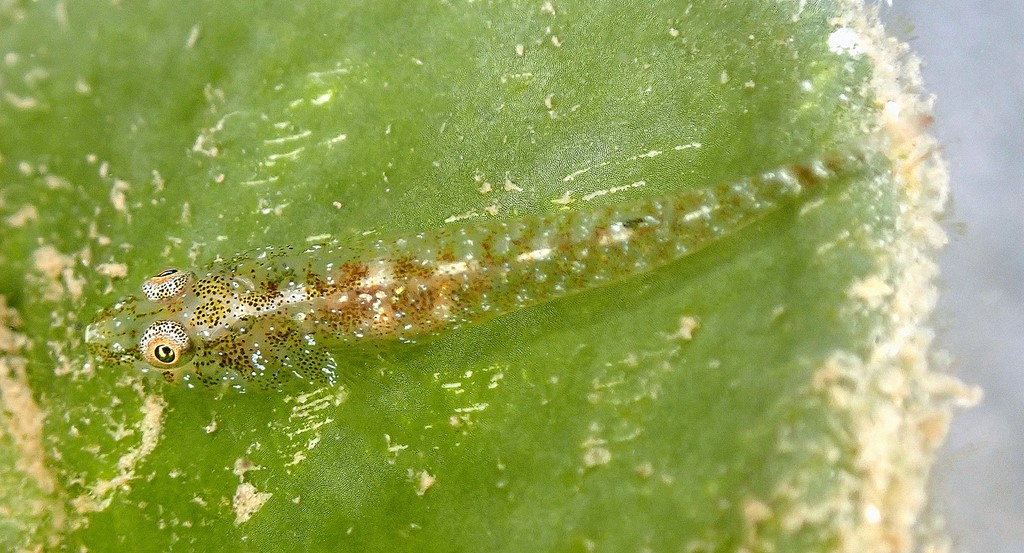PLEUROSICYA BILOBATA - (KOUMANS, 1941)
Picture courtesy of: Amaury Durbano
Actinopterygii (Gigaclass) > Actinopteri (Class) > Teleostei (Subclass) > Gobiiformes (Order) > Gobioidei (Suborder) > Gobiidae (Family) > Gobiinae (Subfamily) > Pleurosicya (Genus)
Seagrass ghostgoby, Seagrass ghost goby, Bilobed ghost goby, Umishôbuhaze, ウミショウブハゼ, 双叶腹瓢鰕虎鱼, 雙葉腹瓢鰕虎魚,
Synonymes
Cottogobius bilobatus (Koumans, 1941)
Pleurosicya bilobatus (Koumans, 1941)
Pleurosycia taisnei (Plessis & Fourmanoir, 1966)
----------------------------
Description
Dorsal spines (total): 6; Dorsal soft rays (total): 1 spine, 7-8; Anal spine: 1; Anal soft rays: 7-8; Pectoral fin rays: 16-19 (usually: 17-18), lower 3-7 rays unbranched and thickened distally. Pelvic fin rays: I + 5, pelvic fins united, cup-shaped. Frenum well developed, laterally with a rounded lobe. Fleshy lobes at each side of the frenum. Scales ctenoid, longitudinal scale series: 23-29, transverse rows: 6-7; Scales on side of body extending forward to above pectoral fin base, side of breast usually scaled, mid predorsal and side of nape naked. Relatively slender body, depth of body at anus averages: 6.7 in SL. Body elongate and compressed. Head depressed. Mouth terminal. Maxilla extending to below anterior margin of pupil. Upper and lower jaws with bands of small teeth, outer enlarged; inner lateral teeth in lower jaw enlarged, two pairs of them are canine-shaped. Tip of tongue bilobate. Vomer with a considerable protuberance. Gill opening extending to a vertical at posterior edge of eye. Max. length : 3.0 cm SL. depth range: 8 - 30 m, usually: 8 - 12 m.
Color
Translucent green to greenish brown, with indistinct irregular brown bars on body, except on belly and breast; A brown band on head from front of the eye to upper lip; Eyes golden-brownish with a red ring around the eye pupil; Males with a black spot posteriorly on the second dorsal fin.
Etymology
Pleurosicya: from Greek, pleura = side, rib + from Greek, sikya, -os = the feminine form of the word, refers to bottle- or flask-shaped (breast-shaped) gourds, therefore, sikyos, the male form, refers to long-fruited (phallic) gourds or melons. Referring to pleural placement of fused, cup-like pelvic fins, i.e., “rib cup” (Helen Larson, pers. comm.).
bilobata: from Latin, bi- = two + from Latin, lobata = lobed. In reference to the bilobate tongue of this species.
Original description: Cottogobius bilobatus Koumans, 1941 - Type locality: Muthivaratu Paar, India.
Distribution
Red Sea; Indo-West Pacific: Saint Brandon's Shoals (Cargados Carajos), Comoros, Mascarenes and India, east to Guam (Mariana Islands) and Papua New Guinea, north to Ryukyu Islands, south to northern Australia and New Caledonia.
Biology
Inhabits shallow reef flats with algae and seagrass habitats. Common on blades of seagrasses. Feeds on small crustaceans taken from the blades or water nearby.
Last update: 22, July 2023
Actinopterygii (Gigaclass) > Actinopteri (Class) > Teleostei (Subclass) > Gobiiformes (Order) > Gobioidei (Suborder) > Gobiidae (Family) > Gobiinae (Subfamily) > Pleurosicya (Genus)
Seagrass ghostgoby, Seagrass ghost goby, Bilobed ghost goby, Umishôbuhaze, ウミショウブハゼ, 双叶腹瓢鰕虎鱼, 雙葉腹瓢鰕虎魚,
Synonymes
Cottogobius bilobatus (Koumans, 1941)
Pleurosicya bilobatus (Koumans, 1941)
Pleurosycia taisnei (Plessis & Fourmanoir, 1966)
----------------------------
Description
Dorsal spines (total): 6; Dorsal soft rays (total): 1 spine, 7-8; Anal spine: 1; Anal soft rays: 7-8; Pectoral fin rays: 16-19 (usually: 17-18), lower 3-7 rays unbranched and thickened distally. Pelvic fin rays: I + 5, pelvic fins united, cup-shaped. Frenum well developed, laterally with a rounded lobe. Fleshy lobes at each side of the frenum. Scales ctenoid, longitudinal scale series: 23-29, transverse rows: 6-7; Scales on side of body extending forward to above pectoral fin base, side of breast usually scaled, mid predorsal and side of nape naked. Relatively slender body, depth of body at anus averages: 6.7 in SL. Body elongate and compressed. Head depressed. Mouth terminal. Maxilla extending to below anterior margin of pupil. Upper and lower jaws with bands of small teeth, outer enlarged; inner lateral teeth in lower jaw enlarged, two pairs of them are canine-shaped. Tip of tongue bilobate. Vomer with a considerable protuberance. Gill opening extending to a vertical at posterior edge of eye. Max. length : 3.0 cm SL. depth range: 8 - 30 m, usually: 8 - 12 m.
Color
Translucent green to greenish brown, with indistinct irregular brown bars on body, except on belly and breast; A brown band on head from front of the eye to upper lip; Eyes golden-brownish with a red ring around the eye pupil; Males with a black spot posteriorly on the second dorsal fin.
Etymology
Pleurosicya: from Greek, pleura = side, rib + from Greek, sikya, -os = the feminine form of the word, refers to bottle- or flask-shaped (breast-shaped) gourds, therefore, sikyos, the male form, refers to long-fruited (phallic) gourds or melons. Referring to pleural placement of fused, cup-like pelvic fins, i.e., “rib cup” (Helen Larson, pers. comm.).
bilobata: from Latin, bi- = two + from Latin, lobata = lobed. In reference to the bilobate tongue of this species.
Original description: Cottogobius bilobatus Koumans, 1941 - Type locality: Muthivaratu Paar, India.
Distribution
Red Sea; Indo-West Pacific: Saint Brandon's Shoals (Cargados Carajos), Comoros, Mascarenes and India, east to Guam (Mariana Islands) and Papua New Guinea, north to Ryukyu Islands, south to northern Australia and New Caledonia.
Biology
Inhabits shallow reef flats with algae and seagrass habitats. Common on blades of seagrasses. Feeds on small crustaceans taken from the blades or water nearby.
Last update: 22, July 2023
